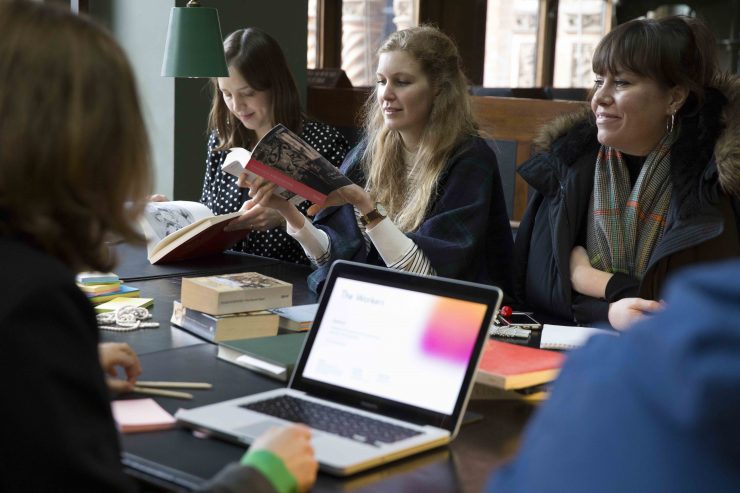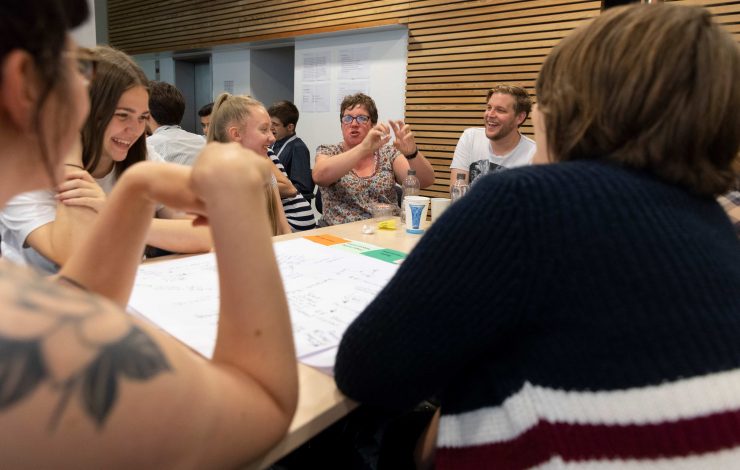How might you bring a ‘difficult’ museum object to life to encourage teenagers to pursue their own creative endeavours? What if that difficult museum object was a Victorian manuscript set in a world and spoken in a language so far removed from 21st century Britain that it’s simply not that accessible? How can you be sure you are creating the right kind of experience for your audience – one that truly captures their interest?
Oliver Twist, A Christmas Carol, David Copperfield – just a handful of Charles Dickens’s timeless classics, yet they’re not the easiest (or shortest!) books to crunch through – not least for the Snapchat generation.
A few of us from the Digital Media team at the V&A, together with immersive theatre experts Punchdrunk and creative technologists the Workers, set out on a mission to create a unique immersive experience for a small group of 14–17 year-olds.
We wanted to bring the work of Charles Dickens to life.

Supported by specialist funding from the AHRC, our goal was to create the ‘next-generation immersive experience prototype’ using technology, theatre and curation in a way that would have a lasting impact on a young audience.
We found that Charles Dickens was a curious character. He loved the theatre, he was a fantastic storyteller, and he wrote his first novel, The Pickwick Papers in his early twenties. It was, we discovered, a common sight to see Dickens in the streets of London reading his books out loud to an audience of strangers.
His background was incredibly humble – he was the epitome of the everyman. His father was in prison for the majority of Dickens’s childhood and the young author had to start working as a boy in a black ink factory to support the family. David Copperfield, the most autobiographical of his works perhaps, uses many references to the way he and his family probably led their lives.
He crafted the stories from his observations – he could spend hours watching people in pubs, and then trawl the streets of London until dawn, letting his thoughts simmer before he’d put them down on paper. His manuscripts, most of them lovingly taken care of as part of the Forster Collection at the V&A’s National Art Library, are full of notes and corrections that help uncover his writing process.

How could we bring this incredible character to life? What were our first steps towards creating the kind of experience teenagers wouldn’t roll their eyes at?
We didn’t know – we had to get them to participate in the creative process with us.
When it comes to building digital products, working very closely with users and stakeholders is the norm within the Digital Media team at the V&A – it’s hard to determine what problems need solving and what consequent features we need to develop without their insights and feedback. We call this process ‘discovery’.
Once our key areas of work are identified, we set ourselves a goal and ways to measure it, and start designing the first prototype. We ensure that it’s functional (i.e. it promises to achieve the project goal) and that the user interface and UX are simple and intuitive.
But could we apply the same techniques to designing a live experience?
We soon realised that designing an immersive experience is much more complex. As much as we could gather data, insights, problems from teenagers and teachers, it was difficult for us to gauge exactly what kind of experience young people would actually like.
What if came up with something we thought was magical, imaginative and innovative, but they still found it… boring? How do you design an experience that doesn’t solve a typical user problem, but needs to be first and foremost enjoyable?
Our biggest fear was designing something that would result in an eye-roll from a fifteen year old.
Working together with the Creative Education Trust and four schools from around the UK, we created two full-day user testing sessions.

We spent the morning immersing fifteen students in the world of Dickens through a guided tour of the V&A – we took them to see Victorian fashion in the Fashion Gallery, showed them the desk slope that Dickens used to write on (on permanent display in the British Galleries) and also presented the innovations in printing from the time. Not everyone knows that his writing was published in short, episodic instalments, which made his writing cheaper, more digestible, and ultimately addictive for those eager to read the next chapters.
(When one of the students remarked that Dickens’s work and publishers back then was like waiting for the next series of Game of Thrones to drop, we thought we were on the right track.)
We then explored Theatre and Performance Galleries, and Dickens’s beloved Theatre Drury Lane and ended the tour in the National Art Library, looking at the original handwritten manuscripts themselves, as well as letters that Dickens exchanged with his agent and best friend John Forster.

The afternoon session was the real deal-breaker for us. Could we get the students to come up with an engaging live experience inspired by what they saw in the morning? How might we structure the session to maximise our chances? How could we help the quiet ones in the group to speak up?
We decided to tackle these problems in two ways.
1) Inspired by Punchdrunk’s devising methods, we created ‘Tools for Immersion’ that would give students prompts and ‘helpful limitations’ to create their idea within.
2) To get the entire group to collaborate, we got facilitators experienced in working with teenagers to join us for the session.
We kicked off the afternoon by noting (on post-it notes) how the students’ perception of Dickens shifted from the morning to the afternoon (from ‘boring’ to ‘flamboyant’ was a particularly good shift!) and we split into small groups of five students.
Each group was supported by a teacher, a Punchdrunk facilitator, a technologist from the Workers and a V&A colleague. We then presented each group with the toolkit and asked them to draw five cards from it.
‘Tools for Immersion’ is effectively five decks of cards we’ve created for the students – each deck representing a component of a live experience:
1) Audience (How many audience members is this experience for?)
2) Place (Where is this experience taking place?)
3) Experience type (What type of live experience is it – a theatre show, escape room or a scavenger hunt?)
4) Technology (What type of technology will you use as part of the experience?)
5) Time (How long does the experience last?)

Each deck consisted of multiple variants, such for ‘Audience’, a group may have pulled out a card that said ‘a group of 5 strangers’, ‘one person only’, ‘a classroom of students’ or ‘a stadium of people’.
The game for the afternoon session?
Choose a card (at random) from each deck and get creating around the theme of ‘A Christmas Carol’ – you have 30 minutes.
(We chose this book by Dickens as most students studied it as part of their curriculum, or knew the film.)
This meant that as a group, you might end up with five cards that might look like this:
– A group of 5 strangers
– In your school
– Escape room
– Geocaching
– 30 minutes

So what were the results from the groups of students like?
From an escape-room-esque dinner experience called A Christmas Crisis to a scavenger hunt around their own school requiring students to break into the forbidden areas of the school like the Head Teacher’s office, staff room or the chemistry lab cupboard, the results were nothing short of surprising, imaginative and genuinely delightful.
Within a museum context, one group went as far as to come up with a museum emergency lockdown after a Charles Dickens manuscript magically disappeared and they needed to find and retrieve it from a ghost of Dickens floating around the Museum.

These were our other findings:
- Most of the students were genuinely very imaginative, they just needed a lot of encouragement to speak up and a lot of affirmation that there’s no right or wrong answers
- They were most interested in – and empathised with – Dickens as a person, and what his life was like
- They loved ghosts
- Contrary to our assumption that we needed to steep the experience in something realistic, we found that they would happily buy into and immerse themselves in an experience that was fictional and designed to be slightly hyper-real or magical
- They knew exactly how to incorporate technology into the experience
- Some students who were extremely quiet became quieter in a group despite the facilitators’ best efforts
- The results didn’t differ vastly between the 4 schools – we didn’t notice major differences in the type of experience a 14 year-old versus a 17 year-old might create
- They navigated towards experiences that were either highly visual or audio-led
- They were not impressed by experiences that were just text-based
- They enjoyed the idea of being immersed in another world – in this case, the world of Victorian London
- They liked to be the heroes of their own stories, playing an active role in solving a problem or a challenge together as a group
- They liked interacting with tangible elements working together with technology – they got excited about finding paper notes, bits of the manuscript, letters, keys unlocking doors
So how did these findings inform our next steps towards creating a production?
All we can reveal is that the final immersive experience prototype involved students coming in to the V&A to give feedback on a new (fictional) exhibition about Dickens. This involved them stepping into a researcher’s study room behind a secret door at the V&A, embarking on a 90’s audio tour around the Museum which got hijacked by a ghost, and ending in an augmented-sound experience that led them to a surprising discovery…
Here’s a small taster from the production…

The ‘Immersive Dickens’ project was shared and showcased at the V&A to 20 selected students who had previously participated in the user testing workshop. It took place on the 27 and 28 September 2018, followed by 6 more invite-only performances for project stakeholders on 2-4 October 2018.



Really helpful article. Thanks https://www.vam.ac.uk